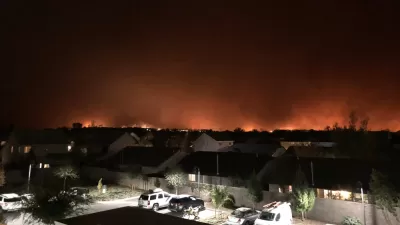InTransition magazine examined the daunting difficulties transportation authorities and the public faced while trying to evacuate Tokyo on the day of the Great Tohuku Earthquake in March.
The article reports that despite a "synchronous failure" of the region's transportation network, infrastructure and technologies, people overall managed to keep calm and get home safely.
"It was 2:46 p.m. on a Friday, three hours before most of Tokyo's huge population of office workers would head home. The transit system was busy with typical off-peak riders, such as shoppers, tourists and children returning from school. With the confirmed detection of a major earthquake (the exact magnitude was, at first, underestimated), all of the major trains were shut down on the spot by operators whether they had power or not. ..."
"[O]f all places, Tokyo, with its huge LED displays and bright-as-daylight-even-at-night intersections, has so often served as the ultimate showplace: Here is how the future will look and how it will work. But the earthquake kicked it over as easily as Godzilla wreaked havoc on cardboard and plaster versions of Tokyo in one of the old movies. Those modern pieces of infrastructure-all hooked together like nerves and circuits to make the city actually run-failed. Sometimes they failed singly, sometimes in groups, but altogether they left a very large metro- politan area minus much of its vital infrastructure, including, of course, the rail systems that weave Tokyo and the larger Kanto area together. ..."
Thanks to Karl Vilacoba
FULL STORY: How a Shaken City Kept Steady Nerves

Alabama: Trump Terminates Settlements for Black Communities Harmed By Raw Sewage
Trump deemed the landmark civil rights agreement “illegal DEI and environmental justice policy.”

Study: Maui’s Plan to Convert Vacation Rentals to Long-Term Housing Could Cause Nearly $1 Billion Economic Loss
The plan would reduce visitor accommodation by 25% resulting in 1,900 jobs lost.

Planetizen Federal Action Tracker
A weekly monitor of how Trump’s orders and actions are impacting planners and planning in America.

Waymo Gets Permission to Map SF’s Market Street
If allowed to operate on the traffic-restricted street, Waymo’s autonomous taxis would have a leg up over ride-hailing competitors — and counter the city’s efforts to grow bike and pedestrian on the thoroughfare.

Parklet Symposium Highlights the Success of Shared Spaces
Parklets got a boost during the Covid-19 pandemic, when the concept was translated to outdoor dining programs that offered restaurants a lifeline during the shutdown.

Federal Homelessness Agency Places Entire Staff on Leave
The U.S. Interagency Council on Homelessness is the only federal agency dedicated to preventing and ending homelessness.
Urban Design for Planners 1: Software Tools
This six-course series explores essential urban design concepts using open source software and equips planners with the tools they need to participate fully in the urban design process.
Planning for Universal Design
Learn the tools for implementing Universal Design in planning regulations.
Caltrans
Smith Gee Studio
Institute for Housing and Urban Development Studies (IHS)
City of Grandview
Harvard GSD Executive Education
Toledo-Lucas County Plan Commissions
Salt Lake City
NYU Wagner Graduate School of Public Service





























